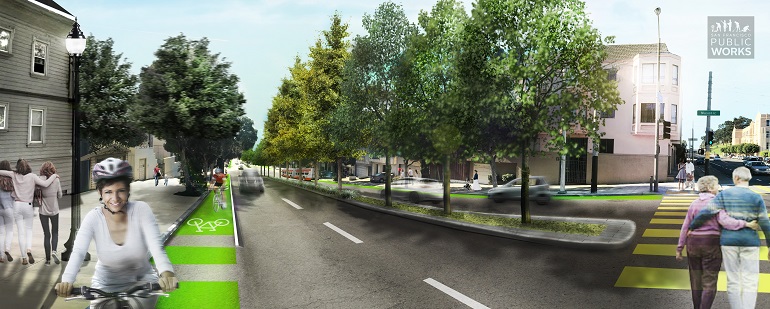We hear the calls for safer streets in the city, and we couldn’t agree more.
On Thursday, we joined Mayor Ed Lee in announcing 57 Vision Zero projects that will be given high priority over the next two years. Some of these projects are new, like a combined education and speed enforcement campaign. Others have been in the planning stages and will now break ground, like our Masonic Avenue Streetscape Project, which will bring new lighting and trees, enhanced bus stops and raised bikeways to a high-crash corridor.
“This is a short list of the many projects that we’ve been working on,” SFMTA Director of Transportation Ed Reiskin said today on KQED’s Forum program. “What is new is our commitment to reach the milestones that we identified on this list by the end of 2017 because we are prioritizing these to get them done.”
Reiskin noted that many of the projects are existing ones that will be accelerated after in-depth planning and analysis.
“One of the underpinnings of Vision Zero is that we are using data to inform the decisions we are making about where to do this work,” Reiskin said. “We aren’t just pulling projects out of the sky and saying it’d be nice to throw down a bike lane there. We are looking at where we are seeing collisions, where we are seeing other indicators and safety problems, and that’s where we are focusing. We have been working with all of the stakeholders, including the Bike Coalition, on this list.”
The priority projects include:
- 22 safety infrastructure projects to be completed by the end of 2017
- 21 more safety infrastructure projects that will reach a major milestone (such as notice to begin construction) by the end of 2017
- 14 enforcement and education initiatives to be completed by the end of 2017
Following on the heels of exceeding our previous goal of completing 24 Vision Zero projects in 24 months, These underscore the city’s commitment to reach zero traffic deaths through engineering, education, enforcement, evaluation and policy changes. These projects are driven by data used to identify the city’s High-Injury Network, the 12 percent of San Francisco streets that account for 70 percent of severe and fatal traffic injuries.
The list also includes a policy initiative to advance an automated speed enforcement bill in the state legislature. Automated speed enforcement is a proven tool to reduce excessive speed, which turns a dangerous collision into a deadly one. We saw that last week with the tragic deaths of Kate Slattery and Heather Miller.
We’ve made strides with projects like the Safer Market Street turn restrictions, which new data from an independent company suggests has reduced dangerous driving behaviors.
Major streetscape transformations are starting construction soon on Polk Street, 2nd Street and Masonic Avenue, which will include raised bike lanes and pedestrian safety measures like sidewalk bulbouts. Construction is already underway on Mansell Drive in McLaren Park, which will see a new physically separated bikeway and walking path. Van Ness Avenue will also see major pedestrian safety improvements along with bus rapid transit upgrades.
But we know we can do more, better, faster, and we’re getting there.
Mayor Ed Lee has challenged us to do more. He has been a strong leader for bike and pedestrian safety, championing the city’s first public transportation ballot measure since 1966. That November 2014 measure secured $500 million for transportation needs, including pedestrian and bike safety measures.
Lee is also advancing a measure on the November ballot that would allocate an additional $100 million a year for transportation, including funding for pedestrian and bike safety projects. Since he took office in January 2011, there have been 89 miles of bikeway improvements in the city
The coordination of city departments to achieve Vision Zero is possible because of the mayor’s commitment to ending traffic deaths.
Recent changes to the California Environmental Quality Act will help us plan, design and implement projects faster. New funding approved on the 2014 ballot has brought more investment to safe streets projects.
Those developments are helpful. But to achieve the vision of San Francisco as a leader for safe streets, even more funding is needed, and building support for changes to how our streets are designed will require working with our communities on tough decisions.
An interactive map of the 57 high-priority Vision Zero projects and the full list can be found on the Vision Zero SF website.
